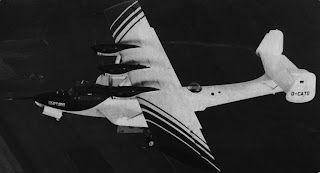 1983
1983Otro proyecto de aviación de Dornier que entró en la etapa de vuelos de pruebas con el exitoso primer vuelo del hidroavión de pruebas Do ATT (anteriormente denominado Do 24 TT) el 25 de abril de 1983 en el aeródromo de Oberpfaffenhofen, perteneciente a la compañía, con el piloto de pruebas Dieter Thomas y el copiloto Meinhard Feuersenger a los mandos.
El programa tenía el objetivo de probar nuevas tecnologías en el campo de los aviones anfibios y estaba apoyado por el Ministerio Federal de Invetigación y Tecnología. El banco de pruebas tecnológico Do ATT fue desarrollado por Dornier sobre la base del antiguo hidroavión Do 24, era un hidroavión experimental con tres turbopropulsores, una nueva ala arriostrada rectangular con un avanzado perfil aerodinámico y un tren de aterrizaje triciclo, utilizando el tren de aterrizaje del Do 31. El programa tenía el objetivo de probar el incremento de la capacidad en alta mar, la flexibilidad de la misión como anfibio , la mejora del rendimiento y de la economía, el nuevo desarrollo del ala y los modernos turbopropulsores en operación en alta mar.
Datos técnicos- Longitud: 21,9 m
- Altura: 6,7 m
- Envergadura: 30,0 m
- Superficie alar: 100,0 m2
- Propulsión: Pratt & Whitney PT6A-45B 3 x 1.125 WPS/SHP
- Peso vacío estándar: 10.070 kg
- Peso máximo al despegue en tierra: 14.000 kg
- Peso máximo al despegue en el mar: 12.000 kg
- Velocidad máxima: 428 km/h
- Velocidad de crucero: 343 km/h
- Distancia de despegue desde tierra: 590 m
- Distancia de despegue desde el agua: 180 m
Do ATT - Amphibian Technology Experimental
Former Designation Do 24 TT
1983
With the successful first flight of the Do ATT (former designation Do 24 TT) amphibian testbed on 25 April 1983 at the Oberpfaffenhofen company airfield with Chief Test Pilot Dieter Thomas and co-pilot Meinhard Feuersenger at the controls, another Dornier aviation technology project entered the flight testing stage. The programme has the objective of testing new technologies in the field of amphibious aircraft and is being undertaken with sponsorship of the Federal Ministry for Research and Technology. The Do ATT technology testbed developed by Dornier on the basis of the former Do 24 flying boat, is an experimental amphibian with three turboprop engines, a new braced rectangular wing with advanced aerodynamic profile, and a tricycle landing gear, using the Do 31 main landing gear. The objective of this experimental programme is the testing of the increased high- seas-going capability, the mission flexibility as an amphibian, the performance and economy improvements, the newly developed wing, and the modern turboprop engines in high-sea operation.
Technical data
- Length: 21.9 m
- Height: 6.7 m
- Wing span: 30.0 m
- Wing area: 100.0 m2
- Propulsion: Pratt & Whitney PT6A-45B 3 x 1,125 WPS/SHP
- Standard empty weight: 10,070 kg
- Maximum take-off weight - land: 14,000 kg
- Maximum take-off weight - sea: 12,000 kg
- Maximum speed: 428 km/h
- Cruise speed: 343 km/h
- Take-off distance from land: 590 m
- Take-off distance from water: 180 m
Fuente: Libro
"Dornier. A Brief History of the Dornier Company" editado por Dornier en 1983




